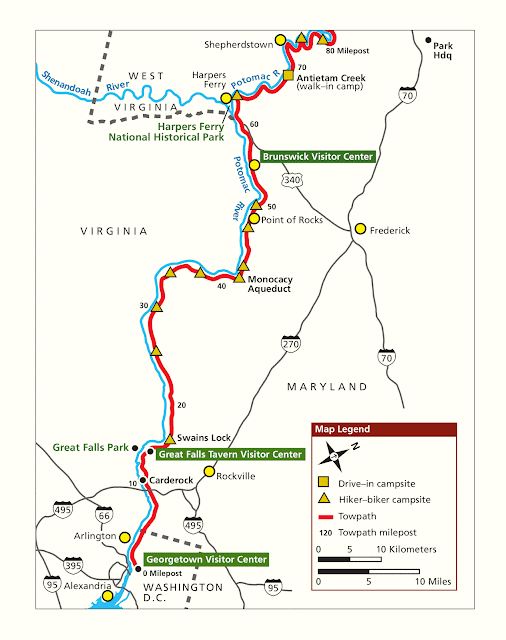 |
| CanalTrust |
The significance of this connection ["between the coalfields of the Allegheny Mountains and the urban markets at the upper reaches of the Chesapeake Bay"] was first appreciated by George Washington, who spent much of his private life surveying and speculating on land in the Potomac headwaters. He knew that linking the Potomac to the Forks of the Ohio (present-day Pittsburgh) would connect the young, coastal nation to the vast resources of the continental interior.Though construction began in 1828, the canal wasn’t completed until 1850, several years after the B&O Railroad had already reached Cumberland. The canal couldn’t compete with rail in terms of speed or capacity, and so it was nearly obsolete from the time of its opening. Only bulk commodities, like lumber, wheat and especially coal, ever depended to any large extent on the canal for access to markets. Nevertheless, the canal operated (with only occasional interruptions in the wake of especially devastating floods) until 1924 when a damaging flood destroyed it beyond repair. People continued to live in cabins and shanties along the canal for another 45 years, until the national park was established in 1971. The canal’s transportation history is particularly evident along the stretch from Seneca to Georgetown where the National Park Service (NPS) has made an effort to keep it watered.
 |
| nps |
 |
| npmaps_upper_detail |
 |
| npmaps_lower_detail |
 |
| npmaps_upper_simple |
 |
| npmaps_lower_simple |
 |
| nps_components 1: aqueducts 2: canal prism (This page has some details about the construction of the canal including the legal battle with the B&O Railroad concerning "the right-of-way from Point of Rocks to Harpers Ferry.") 3: lockhouse 4: lift lock - boat elevator "There are 74 locks in total! You may say, "But there is a lock named Lock 75!" And that is because Lock 65 doesn't exist. When the canal was constructed they realized that they didn't need to build a Lock 65. The builders found it was too much work to change the name of every lock after 65 in the paperwork." The average lift was 8' (2.4m) and the max lift was 10' (3m). |
.jpg) |
| GeorgetownHeritage Congress wanted to fill in the canal and create a parkway for automobiles. But preservationists objected and The Canal was designated a National Historical Park in 1971. |
Judging by the scale on this map, it looks like the locks could handle a 14' x 80' canal boat.
 |
| Satellite via Lock #44 |
Canal artifacts that I have noted:
No comments:
Post a Comment